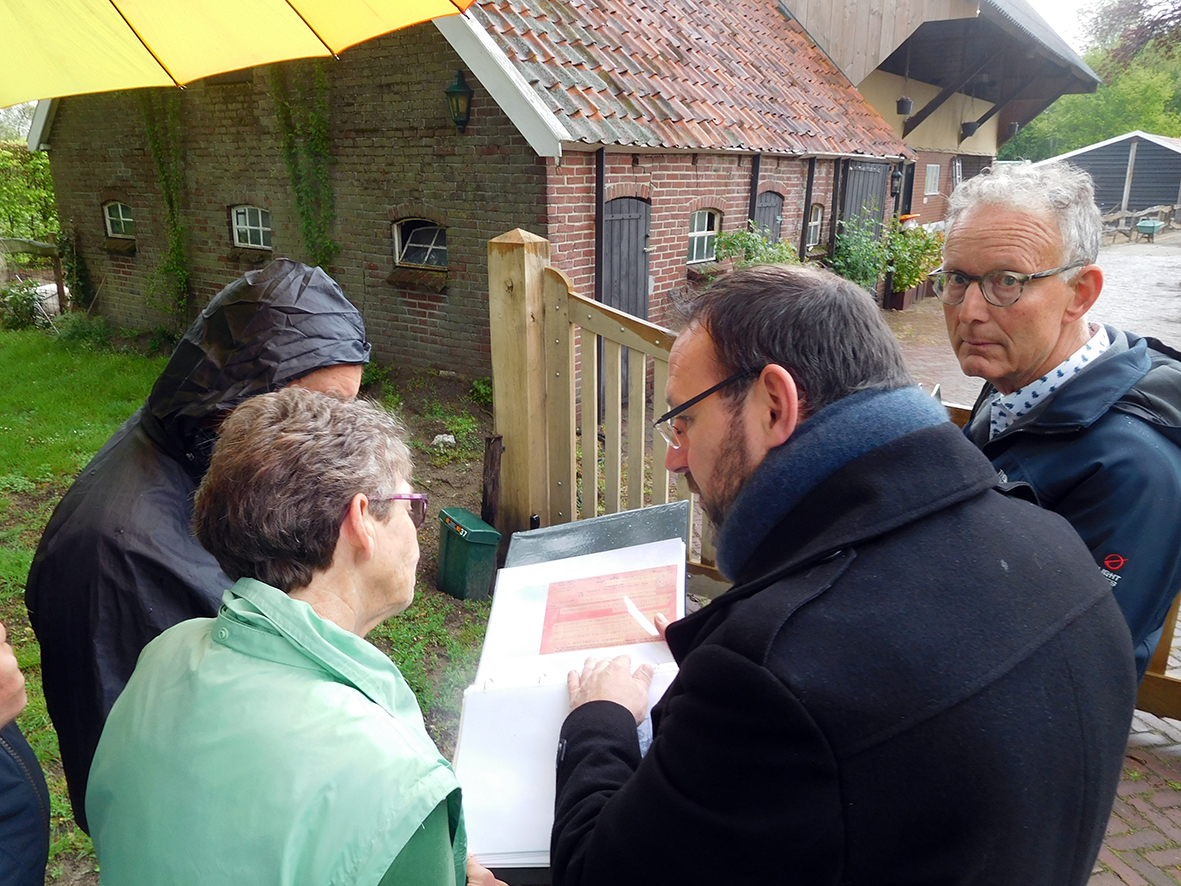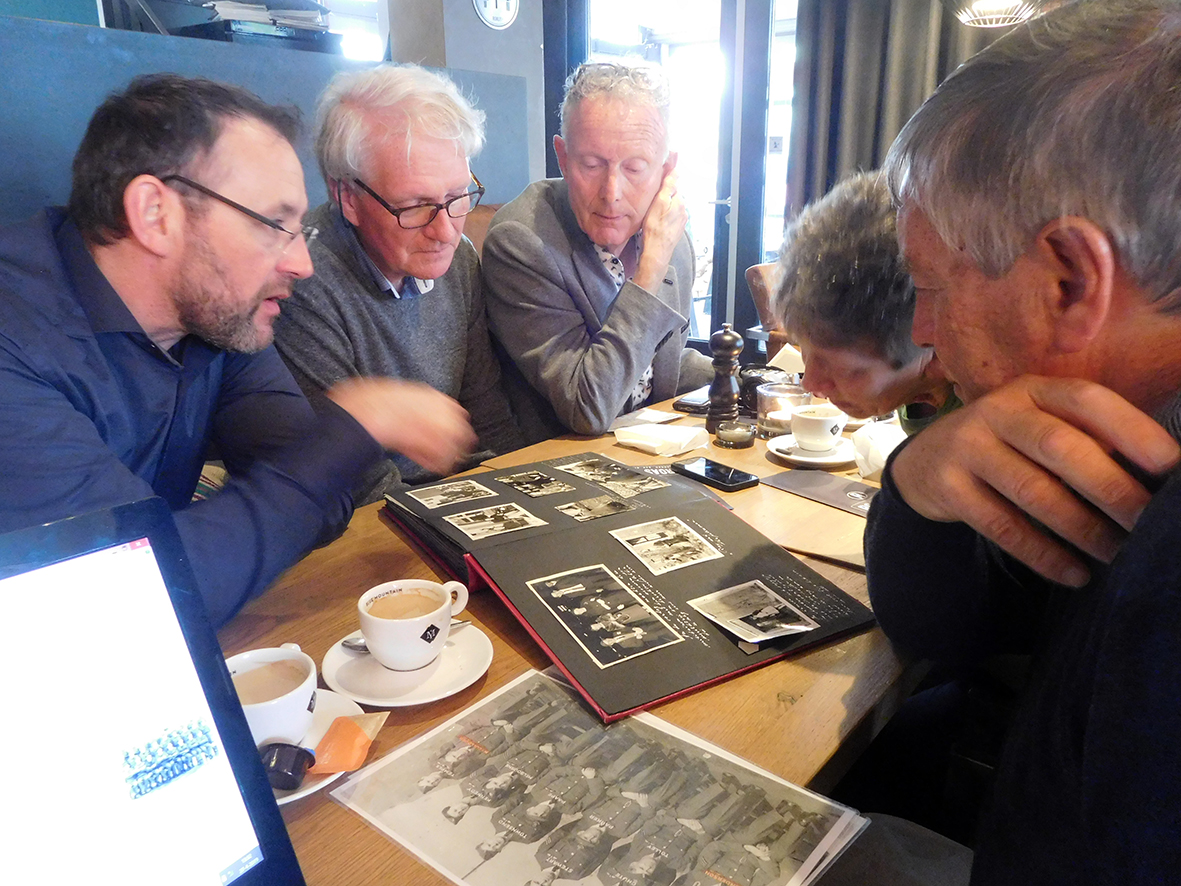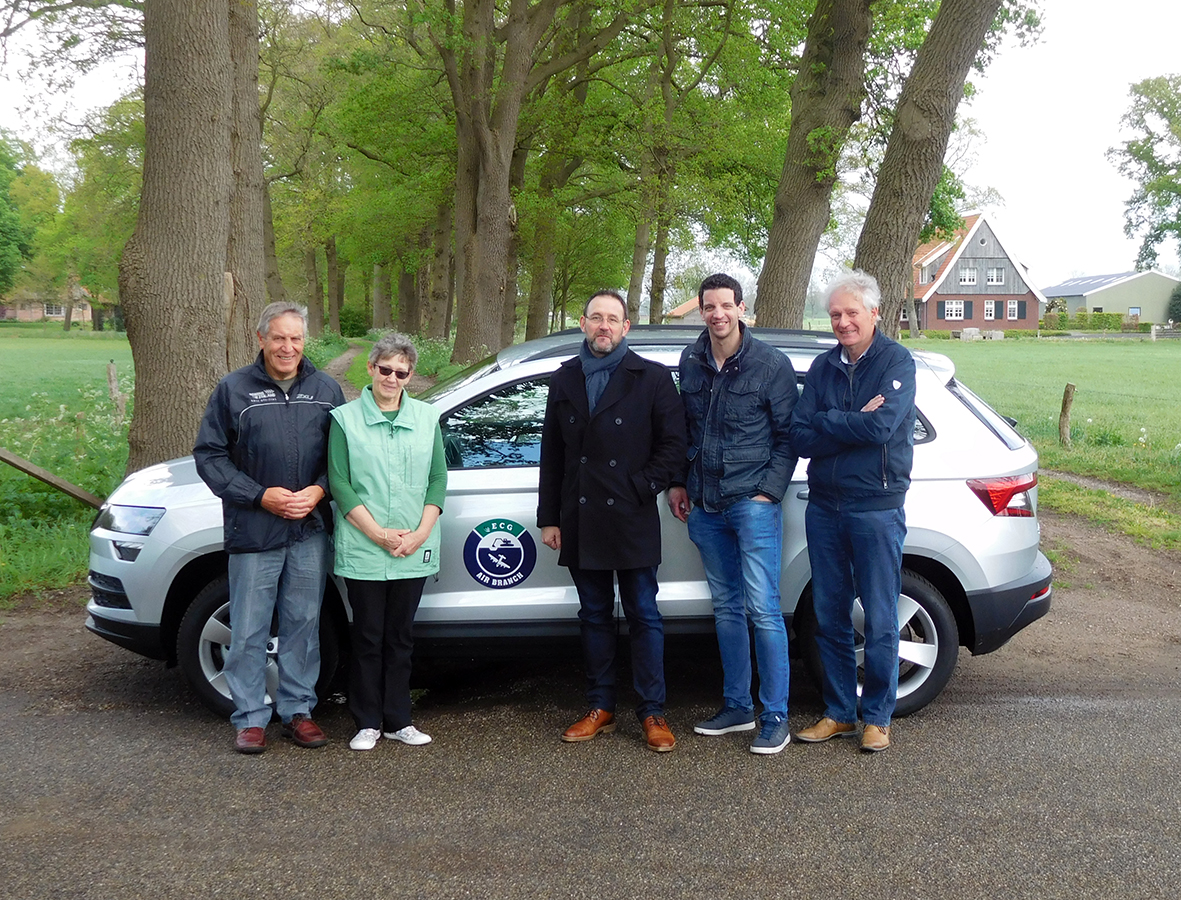Een dag vol emoties: ECG Air Branch verzorgt Battlefieldtour aan Nieuw Zeelandse familie van piloot
Op zaterdag 27 april mocht ECG Air Branch een battlefieldtour verzorgen aan de Nieuw Zeelandse familie Sinclair. Doel: dochter Geal Sinclair en haar man Peter wilden in de voetsporen van haar vader, die zelf ooit als piloot van een bommenwerper boven Oost-Nederland was neergeschoten en met een parachute was afgesprongen. Om een reconstructie mee te maken kwamen de Sinclairs speciaal voor dit doel naar Nederland overgevlogen en ons afdelingshoofd en projectleider Coen Cornelissen bezorgde ze een onvergetelijke dag.
Geal Sinclair is de dochter van Raymond Henderson. Pilot Officer Raymond Henderson, destijds 25 jaar en behorend tot het No.75 Royal New Zealand Air Force Squadron, om precies te zijn. Om u een beeld te schetsen, nemen we u even mee naar een winteravond in 1943 en wel de nacht van woensdag 3 op 4 februari 1943. De nacht, dat de Royal Air Force, Hamburg ten doel had en een strijdmacht op weg stuurde van 263 bommenwerpers. Een daarvan was de viermotorige Short Stirling Mk.I BK604 AA-S van de 30-jarige Pilot Officer John McCullough uit Christchurch, de stad uit Nieuw Zeeland die we vandaag de dag, helaas, inmiddels ook vanuit een andere context kennen. En naast hem zat co-pilot Ray Henderson uit Kemmington, New Zealand.

Reeds op de heenweg ging het mis… Om exact tien minuten over acht doorbrak hoog in de lucht een knetterend vuursalvo de stilte. Hierop verscheen een lichtschijnsel in het donkere firmament en langzaam daalde deze als een razende, oncontroleerbare vuurbal, naar de aarde. Het was een brandend vliegtuig! De Stirling AA-S.
Boven het Twentse landschap had nachtjageraas Hauptmann Wolfgang Thimmig, de ‘Gruppenkommandeur’ (Squadron-Leader) van de III. Gruppe van het Nachtjagdgeschwader 1 gewacht in zijn Messerschmitt Bf.110. En op 4200 meter hoogte, van een afstand van 100 tot 50 meter, wist de nachtjager met exact 464 schoten uit de boordmitrailleurs en 32 granaten uit de 2 cm boordkanonnen de Britse bommenwerper in brand te schieten. Vanonder het plexiglazen cockpitdak konden Thimmig en zijn marconist Steckemetz waarnemen hoe de tegenstander aan zijn laatste dodenvlucht begon…
Vliegend ging het vanaf Borne richting Bornerbroek, in algeheel noordwestelijke richting. Daarna boog de machine pal westwaarts richting Enter. Ten noorden van Enter zakte de brandende luchtreus zuidwaarts, vloog gierend over Enter heen, om tenslotte boven de Goorseweg met een dreun in de lucht uiteen te spatten.
Henderson en Kimberley, een 21-jarige boordschutter uit Birmingham, landden veilig nabij Bornebroek aan de grond. Ray Henderson belandde daarbij met zijn parachute in een boom en brak enkele ribben. Meer naar het westen, bij het Twentekanaal, landde radiotelegrafist Sgt. Smith, die daarbij zijn been brak. Ook navigator Gibbes moet daar ergens neer zijn gekomen. Met bommenrichter Sgt. Terence A. Murphy uit Matamau, Nieuw Zeeland verliep het minder goed. Murphy wist nog wel zijn parachute aan zijn harnas te klikken, sprong, maar was waarschijnlijk te laat en viel te pletter ten noorden van Enter, bij het buurtschap Rectum bij ‘Busger op Vollenbroek’. Vol afschuw zagen buurtbewoners de volgende dag, hoe het stoffelijk overschot van de onfortuinlijke man, als een paal recht in de grond stond. Hij was tot zijn middel in een weiland geboord…
Ook bij het wrak was een macaber toneel van dood en verderf zichtbaar. Een van de ongelukkigen stond op de kop in een houtstapel van de houtzagerij. Zijn laarzen waren verdwenen en tot grote woede van velen werd vermoed dat die ontvreemd waren… En zo vonden vier jongemannen, zo maar op een februari nacht in 1943, de dood rondom het Twentse Enter. Het waren McCullough de piloot. Verder de 19-jarige radiotelegrafist/ schutter Paul Trevayne, de Britse boordwerktuigkundige Sgt. Francis F. Allen en tenslotte de arme Terence Murphy.
Henderson werd samen met Kimberley aangetroffen bij een boer in Bornerbroek. De politie werd gewaarschuwd en postcommandant Arts stuurde er een patrouille op af. Ook Marechaussee P. van Luinen werd opgetrommeld. “Afgelopen nacht is bij Enter een Engels vliegtuig neergestort. Bij ons thuis zijn twee overlevenden, die zo dadelijk door de Duitsers worden opgehaald.” Ogenblikkelijk sprong Van Luinen op zijn dienstfiets en zette het hem op een draf naar Arts. Daar trof hij in Bornebroek zowel Henderson als Kimberly. Voordat de twee vliegers naar Borne werden gebracht, maakte Van Luinen snel twee kiekjes van het tweetal. Daarna toog het naar het gemeentehuis van Borne en daar kwamen uiteindelijk de Duitsers die de geallieerden gevangen namen en afvoerden.
Nu hebben wij al verschillende tours en rondleidingen verzorgd in het kader van de Stirling AA-S. Bijvoorbeeld aan Max Thimmig, kleinzoon van de succesvolle Duitse nachtjager. Maar ook aan de familie Trevayne (Karen Travayne), die zelf ieder jaar naar Nederland komt. Onlangs kon Diederick ten Brinke uit Enter, zelf helemaal gespecialiseerd op de gebeurtenissen rondom deze crash, de familie Kimberly rondleidden en ook bestaan nauwe en warme contacten met Russell Murphy, de neef van de omgekomen bommenrichter.
 Vandaag verzorgde ons afdelingshoofd en projectleider van ECG Air Branch Coen Cornelissen, namens Explosive Clearance Group, een tour langs alle plaatsen waar het destijds allemaal gebeurde. Geal en Peter Sinclair werden hierbij vergezeld door de gebroeders Van Luinen. Twee zoons van de oud Mareschaussee, die zelf inmiddels allang is overleden. Ook zij waren nieuwsgierig naar wat hun vader die nacht had meegemaakt. Coen werd hierbij prima geassisteerd door Diederick ten Brinke. Een door Explosive Clearance Group georganiseerde lunch in Borne bracht de emoties weer een beetje tot bedaren. Via Borne, Bornerbroek, de crashsite in Enter aan de Goorseweg, de locatie waar Murphy zijn parachutesprong zo fataal eindigde, ging het gezamenlijk naar het kerkhof aan de Appelhofstraat in Wierden. En zo eindigde een emotionele dag waardig in stilte bij de graven van een stel jonge kerels, die ooit, lang geleden – maar toch zo dichtbij – hun leven gaven voor een groot goed. Onze vrijheid! We shall remember them.
Vandaag verzorgde ons afdelingshoofd en projectleider van ECG Air Branch Coen Cornelissen, namens Explosive Clearance Group, een tour langs alle plaatsen waar het destijds allemaal gebeurde. Geal en Peter Sinclair werden hierbij vergezeld door de gebroeders Van Luinen. Twee zoons van de oud Mareschaussee, die zelf inmiddels allang is overleden. Ook zij waren nieuwsgierig naar wat hun vader die nacht had meegemaakt. Coen werd hierbij prima geassisteerd door Diederick ten Brinke. Een door Explosive Clearance Group georganiseerde lunch in Borne bracht de emoties weer een beetje tot bedaren. Via Borne, Bornerbroek, de crashsite in Enter aan de Goorseweg, de locatie waar Murphy zijn parachutesprong zo fataal eindigde, ging het gezamenlijk naar het kerkhof aan de Appelhofstraat in Wierden. En zo eindigde een emotionele dag waardig in stilte bij de graven van een stel jonge kerels, die ooit, lang geleden – maar toch zo dichtbij – hun leven gaven voor een groot goed. Onze vrijheid! We shall remember them.
